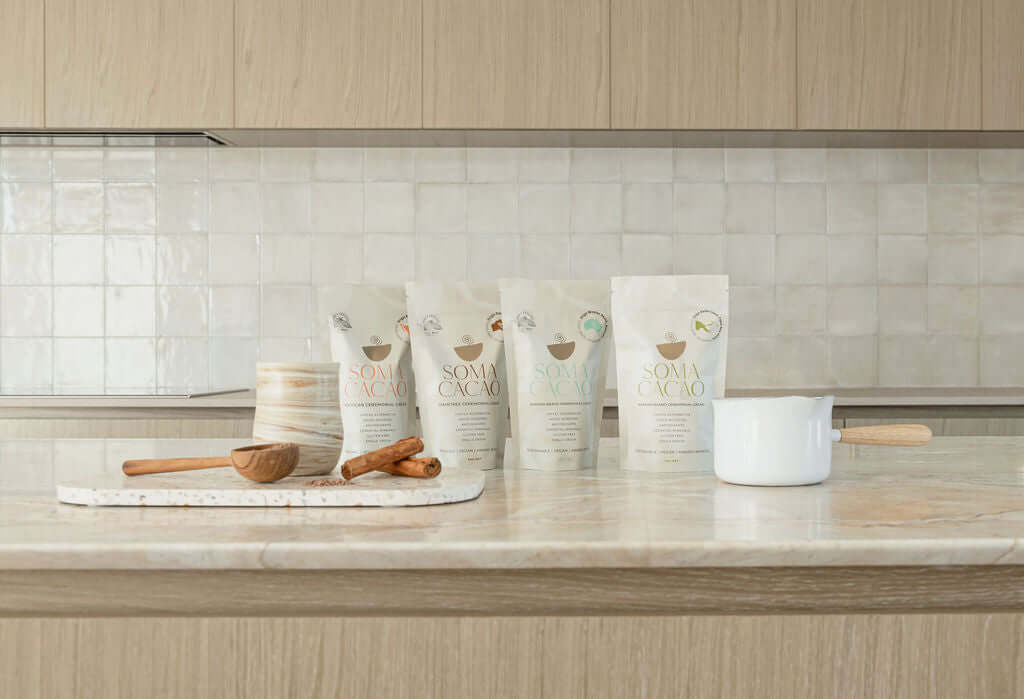9 Self-Soothing Micro-Practices for Anxiety

We know that many of you have made the switch from coffee to cacao to help with anxiety, and it’s not surprising given the effects caffeine can have on the nervous system. In Australia alone, 32.0% of females and 20.4% of males aged 16 to 85 will experience an anxiety disorder in their lifetime—those are big numbers!
Research shows that coffee consumption can increase anxiety levels, particularly for those who are already prone to anxious thoughts or panic disorders. The caffeine in coffee acts as a stimulant on the nervous system, often leading to the jittery, uneasy sensations many people associate with anxiety.
In contrast, cacao contains only a small amount of caffeine but a larger quantity of theobromine—a compound that is often described as “same same, but different.” Theobromine acts on the cardiovascular system, dilating blood vessels, allowing blood to flow more freely, and reducing blood pressure. This action may help explain why theobromine feels less jittery than caffeine. Additionally, cacao is rich in valeric acid and magnesium, two well-known natural stress relievers.
Our journey with cacao has deepened our understanding of anxiety—its causes and how it impacts the body. Along the way, we’ve discovered a variety of micro-practices that have been scientifically proven to help manage anxiety. Here are nine of our favourite self-soothing techniques, and of course, we’re especially fond of number 9 😉.
1. Heel Drops
This grounding exercise helps to reduce anxiety by shifting your focus to the body’s connection with the ground. Stand on your tiptoes, then drop down onto your heels, creating a soft thudding sound.
Feel the vibration travel from your feet up through your torso. Rock up and down in a rhythmic motion for at least one minute. This simple action can help release pent-up tension and create a sense of stability, bringing you back to the present moment.
2. Change Your Environment
Sometimes, a shift in environment is all it takes to calm the mind. Step outside for a moment, focus on greenery, or find a soothing indoor space with natural light or calming ambiance.
A 2019 study in Frontiers in Psychology showed that spending even a few minutes in nature can significantly reduce cortisol levels, the hormone responsible for stress. Whether it’s a quick walk or simply looking out a window, changing your scenery can have a powerful effect on your mood.
3. Bilateral Stimulation
Bilateral stimulation is a technique often used in therapies such as Eye Movement Desensitization and Reprocessing (EMDR) and is known to reduce anxiety. Simply cross your arms over your chest, placing your right hand on your left shoulder and your left hand on your right shoulder.
Gently alternate tapping each shoulder in a consistent rhythm for 3 to 5 minutes. This helps to calm the nervous system by engaging both hemispheres of the brain and promoting a sense of balance.
4. Take a Warm Shower or Bath
Water has a soothing effect on the nervous system, and a warm shower or bath can help alleviate anxiety. The warmth helps to relax tense muscles, and the ritual of cleansing offers a form of self-care that encourages mindfulness.
Use your favourite soothing body wash or bubbles, and don’t forget a soft, fresh towel for afterward.
5. Focused Breathing
One of the quickest ways to calm anxiety is through focused breathing. Slow, deliberate breaths help to stimulate the parasympathetic nervous system, which is responsible for bringing the body back to a state of calm.
Try breathing in for a count of 3, holding for 4, and exhaling for a count of 5. This controlled breathing technique has been shown to reduce stress and improve mental clarity by lowering cortisol levels and reducing the heart rate.
6. Self-Soothing Touch
Touch has a profound impact on the nervous system, and simple gestures like placing your right hand on your heart and your left hand on your belly can create a sense of comfort.
As you focus on the rise and fall of your breath, notice how this gentle pressure grounds you and helps to regulate your emotions. Continue for 3 to 5 minutes, or longer if needed, to allow the calming effect to settle in.
7. Ear Massage
Massaging the outer edges of your ears stimulates nerve endings that can help reduce anxiety and promote relaxation. Start at the top of the ear and, using your thumb and forefinger, rub gently as you work your way down the edge of the ear.
This practice increases blood flow to the head, helping to wake up the brain while calming anxious thoughts. The ear has numerous acupressure points linked to relaxation and stress relief.
8. Hum, Chant, or Sing
The vagus nerve, which runs from the brainstem down through the throat, plays a key role in regulating the body’s stress response. Repeated vocalization, whether it’s humming, chanting, or singing, stimulates the vagus nerve and can help create a sense of calm.
Even if you don’t consider yourself a singer, the act of vocalizing has been shown to reduce stress and anxiety by activating this nerve. If you’ve ever enjoyed singing in a group, try imagining your favourite people singing along with you for an extra boost of joy.
9. Drink Cacao
Last but not least, cacao is an incredible tool for reducing stress and anxiety, thanks to its high levels of magnesium and valeric acid. These compounds work together to lower stress hormones and relax the muscles.
Cacao also contains PEA (phenethylamine), which triggers the release of endorphins and mood-enhancing neurochemicals in the brain—similar to the feeling of being in love! In addition, cacao is rich in serotonin, anandamide (the “bliss molecule”), and theobromine, all of which promote relaxation and elevate mood.
The science behind cacao’s calming effects is extensive, and it's no wonder why so many people are turning to it as a natural remedy for anxiety.
Conclusion
Whether you're trying heel drops, focused breathing, or indulging in a warm cup of ceremonial cacao, these micro-practices can be incorporated into your daily routine to help reduce anxiety in just a few minutes. Each practice has its own unique way of soothing the mind and body, and over time, these small moments of self-care can make a big difference.
Let us know which practice resonates with you the most—and how cacao has helped you manage your anxiety!
References
-
Hunter, R. F., & Cleland, C. L. (2019). The positive effects of nature on mental health: A systematic review of environmental research. Frontiers in Psychology, 10, 1848.
-
Shapiro, F. (2017). Eye Movement Desensitization and Reprocessing (EMDR) Therapy: Basic Principles, Protocols, and Procedures. Guilford Publications.
-
Lewis, D. (2016). The impact of cacao on stress and anxiety levels: A comprehensive review. Nutritional Neuroscience, 19(2), 75-83.
- Tags: Mental Health


































